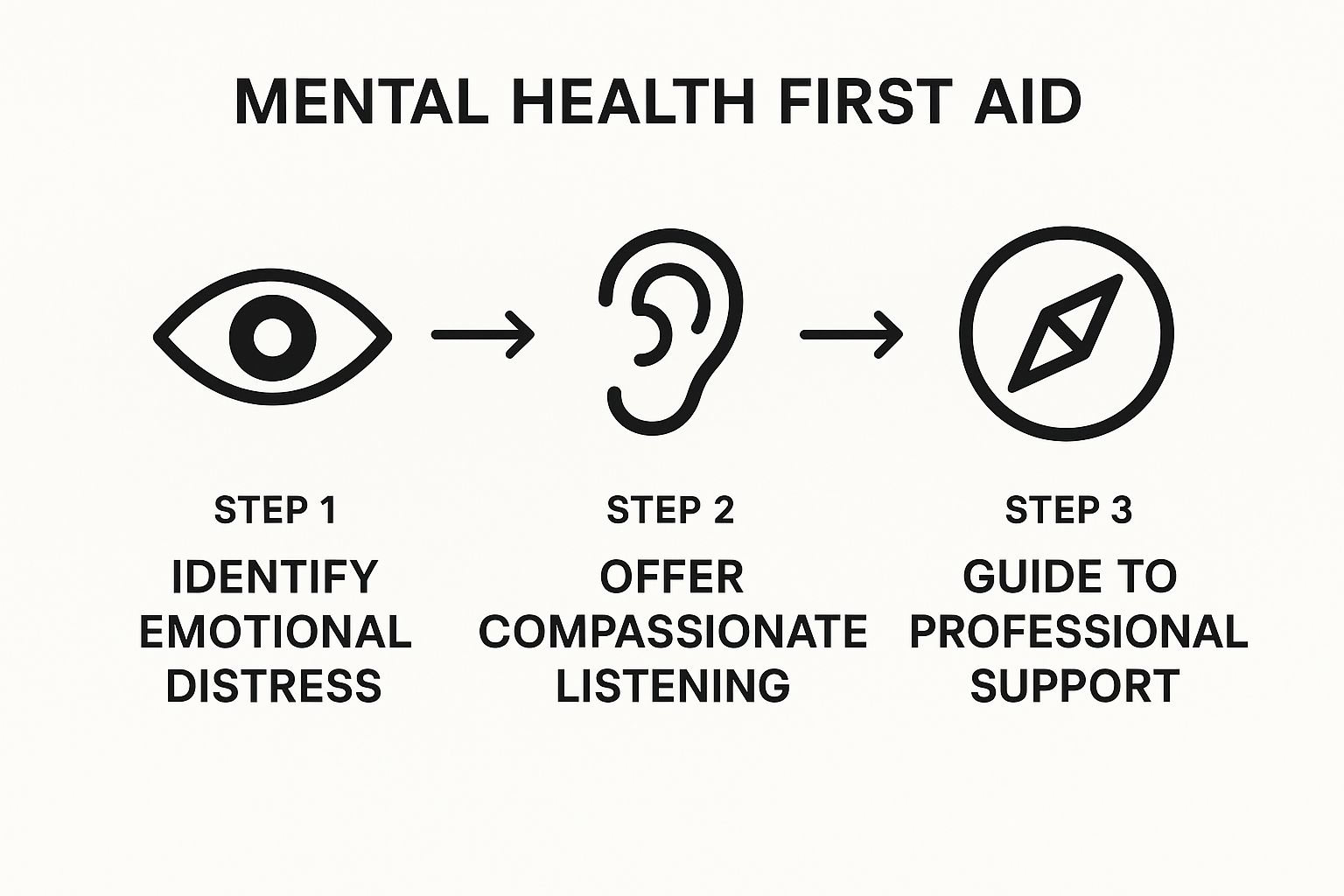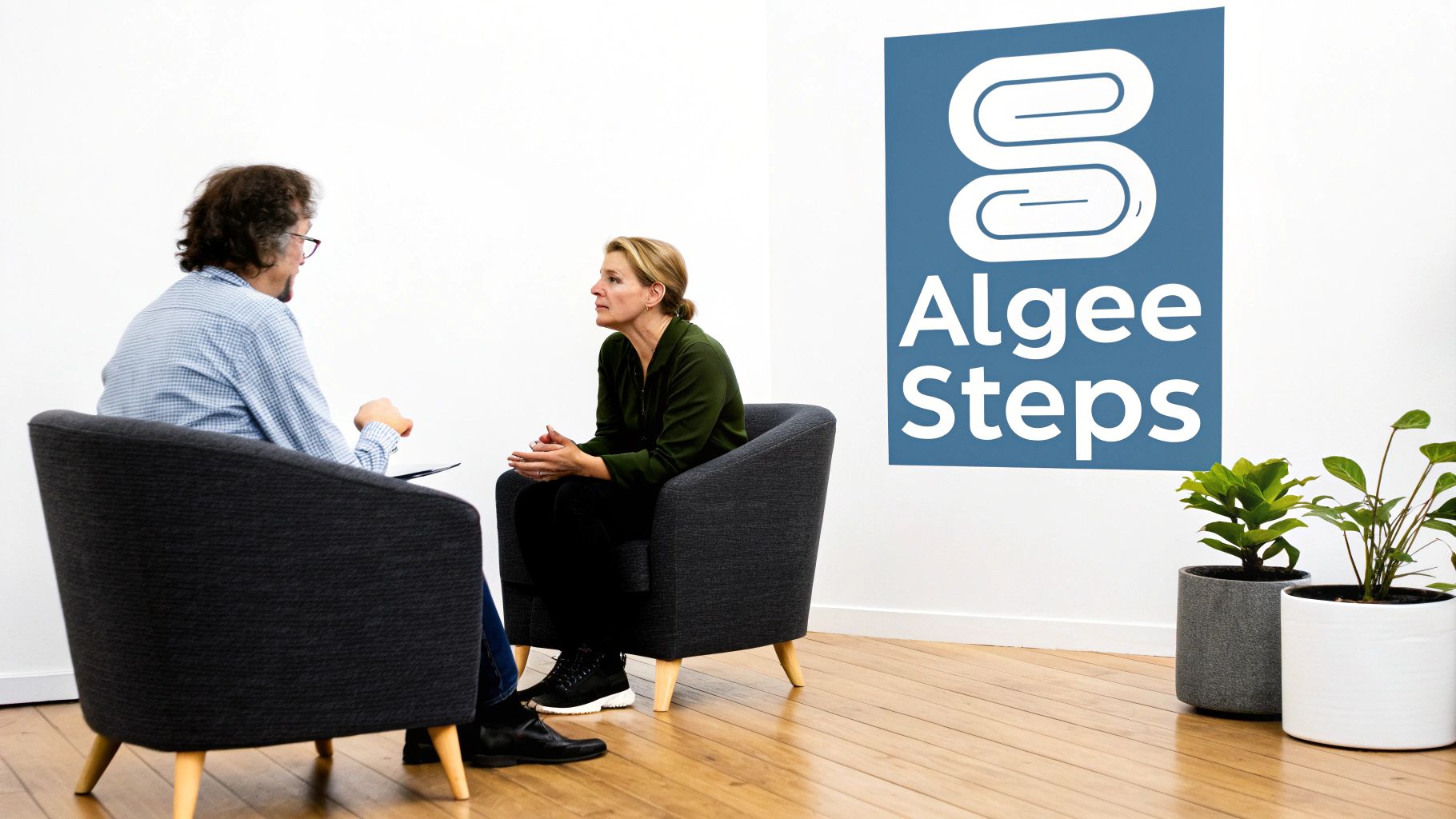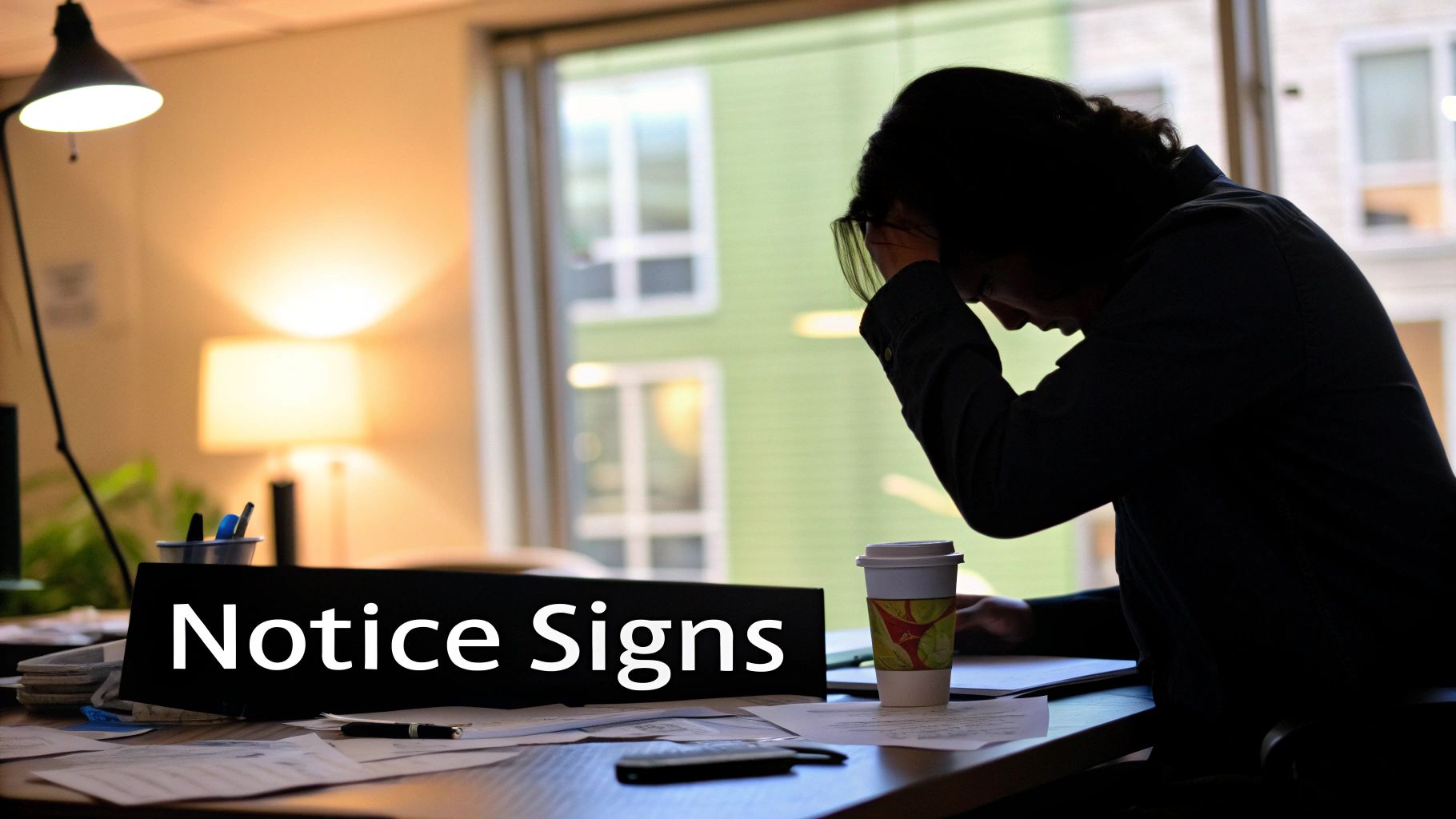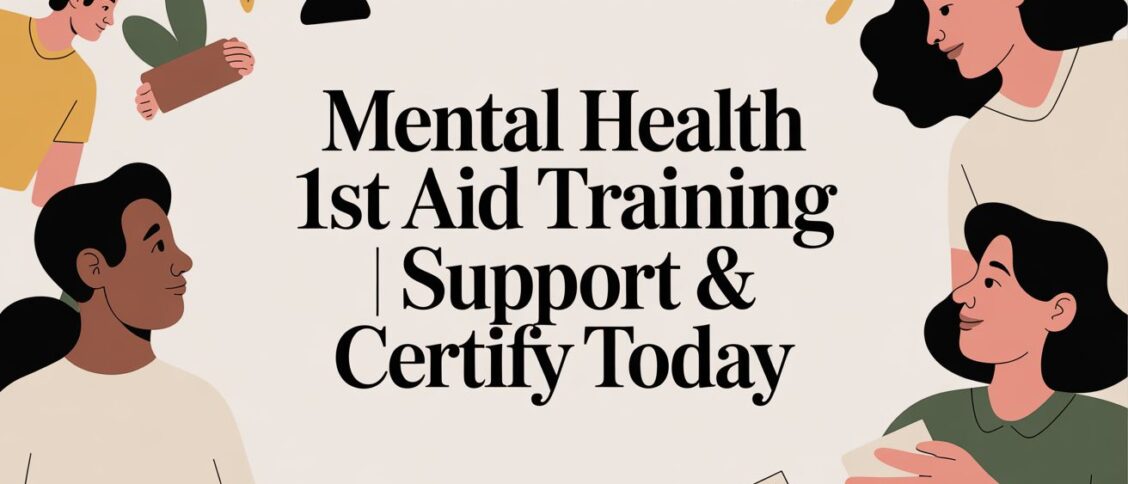Think of it this way: if someone tripped and scraped their knee, you’d know what to do. You’d probably grab a plaster, help them clean it up, and suggest they see a doctor if it looked nasty. You wouldn’t be expected to perform surgery on the spot, right?
Mental Health First Aid is exactly the same idea, just for emotional and psychological wellbeing.
So, What Is Mental Health First Aid, Really?
It’s not about becoming a therapist overnight. Far from it. It’s about learning a practical set of skills that empowers you to be a first responder for someone in emotional distress.
You learn how to spot the early warning signs that someone might be struggling. You learn how to listen without judgement, offer reassurance, and gently guide them towards the right professional support. You become a crucial first point of contact.
This infographic breaks down the core approach into a simple, memorable process.

As you can see, it’s all about awareness and connection, not clinical diagnosis.
Demystifying The First Aider’s Role
A trained Mental Health First Aider is taught how to create a safe space for someone to open up. They learn how to approach those tricky conversations with confidence and empathy, making the person feel heard and supported, not judged.
The goal is to be a bridge, not the final destination. You’re there to provide comfort and direction, making sure no one has to face a mental health crisis alone while they wait for professional help to kick in.
This kind of proactive support is a game-changer. It helps to break down the stigma and normalise talking about our mental wellbeing. It encourages people to seek help much earlier, often before a small struggle snowballs into a full-blown crisis. If you want to get better at starting these chats, my guide on the stress-free steps to opening up a dialogue about mental health is a great place to start.
Why This Skill Is Gaining So Much Traction
The need for these skills is finally getting the recognition it deserves, in our workplaces and communities alike. Here in Ireland, the uptake of Mental Health First Aid (MHFA) training shows just how seriously we’re starting to take mental health literacy.
In fact, over 40,000 people in Ireland have now been trained in MHFA. That number is climbing every year, thanks to brilliant initiatives in businesses, schools, and local community groups.
Ultimately, mental health first aid is about building more compassionate, resilient communities. It gives everyday people the confidence to step in and offer support, proving you don’t need to be a clinical expert to make a huge difference in someone’s life.
Getting to Grips with the ALGEE Action Plan

At the heart of Mental Health First Aid is a simple but powerful framework known as ALGEE. It’s a five-step action plan that gives you a clear, memorable structure for offering support safely and effectively. It’s not a rigid script you have to follow word-for-word, but more of a reliable guide to help you navigate a sensitive conversation with confidence.
The best way to think of it is like the “DRSABCD” (Danger, Response, Send for help, etc.) we learn for physical first aid. ALGEE gives you a dependable sequence to follow when you spot someone struggling, making sure you cover the most important bases in a logical order. It turns that well-intentioned thought of “I want to help” into real, practical action.
So, let’s break down what each of those letters actually stands for and what it looks like in the real world.
The ALGEE Action Plan at a Glance
Before we dive deep, here’s a quick overview of the five steps. This table lays out the entire framework, showing how each part builds on the last to create a complete supportive response.
| Step | What It Stands For | Core Purpose |
|---|---|---|
| A | Assess for risk of suicide or self-harm | To ensure the person’s immediate safety before anything else. |
| L | Listen non-judgementally | To create a safe, supportive space for them to share their experience. |
| G | Give reassurance and information | To offer hope and combat feelings of isolation with facts and empathy. |
| E | Encourage appropriate professional help | To bridge the gap between their current struggle and expert support. |
| E | Encourage self-help and other support strategies | To empower them with practical tools they can use for their own wellbeing. |
This plan provides a clear pathway from identifying a problem to connecting someone with the right kind of support, all while keeping them—and you—safe.
A is for Assess for Risk
First things first: safety. This initial step is all about calmly and gently checking for any immediate risk of suicide or self-harm. You don’t have to be a crisis negotiator, but you do need the courage to ask direct, compassionate questions.
For instance, if someone is expressing feelings of complete hopelessness, a trained Mental Health First Aider learns how to ask, “Sometimes when people feel this way, they have thoughts of ending their life. Have you been having thoughts like that?” It might feel uncomfortable, but that directness can be life-saving.
If the answer is yes and you believe they’re at immediate risk, your role is to stay with them and get professional help involved straight away, whether that’s by calling emergency services or a crisis line. This is the most critical part of mental health 1st aid.
L is for Listen Non-Judgementally
Once you’ve established that the person is safe for the moment, the next step is to simply listen. It sounds easy, but really listening without judgement is a skill. It means giving someone your full attention, letting them tell their story in their own time, and fighting that natural urge to jump in with advice or your own anecdotes.
You’re trying to create a space where they feel truly heard, without any fear of being criticised or having their feelings dismissed. You aren’t there to solve their problems—you’re there to understand their world for a minute. The simple act of being listened to can be incredibly validating for someone in distress.
True listening is more than just hearing words; it’s about paying attention to the emotions behind them. It’s about offering empathy, not solutions.
If you want to sharpen this skill, our guide on the 4 listening skills every leader should master has some fantastic tips that are useful for everyone.
G is for Give Reassurance and Information
After listening, it’s time to offer some realistic reassurance. This isn’t about making empty promises like, “Don’t worry, everything will be fine!” Instead, it’s about giving hope and factual information that helps the person feel less alone.
Simple, genuine phrases like, “Thank you for sharing this with me,” or “That sounds incredibly difficult, and it makes complete sense that you’re feeling this way,” can make a huge difference. You can also gently challenge feelings of hopelessness by reminding them that mental health challenges are treatable and that recovery is absolutely possible.
E is for Encourage Professional Help
A Mental Health First Aider is a bridge to professional support, not a replacement for it. This step is about gently encouraging the person to connect with a qualified professional, like their GP, a therapist, or a counsellor.
You can make this feel less daunting by helping them explore their options. You might say something like, “There are people who are trained to help with exactly this. Would you be open to the idea of talking to a professional?” Sometimes, just offering to help them find a local service or look up a phone number can be the push they need.
E is for Encourage Self-Help
Finally, you can point them towards self-help strategies that support wellbeing. This could mean suggesting things that have helped them feel better in the past, like getting outside for a walk, prioritising sleep, or trying a mindfulness exercise.
In moments of high stress, knowing a few practical, in-the-moment tools can be a game-changer. For example, suggesting some effective breathing techniques for anxiety attacks can provide immediate relief. These simple, actionable strategies help empower the person to take an active role in their own recovery, working alongside any professional support they receive.
Recognising When Someone Might Need Support

One of the biggest skills in mental health 1st aid isn’t about having all the right words. It’s about learning what to see. It’s about being tuned in enough to notice when someone around you might be struggling, often long before they ever say anything out loud.
This isn’t about playing detective or trying to diagnose anyone—far from it. The real goal is much simpler: to spot changes in someone’s behaviour that suggest they’re finding things a bit tough.
Think of it like this: you notice a friend has started limping. You don’t know if it’s a sprain, a blister, or something more serious, but you can clearly see their usual walk has changed. Picking up on shifts in someone’s mental wellbeing works in a very similar way.
Looking Beyond the Obvious Signs
Sometimes, the signs of a mental health challenge are easy to spot. But more often than not, they’re subtle shifts in a person’s day-to-day behaviour, their mood, and how they interact with others. What we’re really looking for is a change from their usual self.
For instance, a colleague who is normally on top of everything might start missing deadlines or seem a bit dishevelled in meetings. Or a mate who lives for their weekly five-a-side might suddenly stop showing up, giving vague excuses every time. These are the small flags that tell you something might be up.
These behavioural clues are often the first visible signs that someone is trying to carry more than they can handle. It’s not about a single off day, but a pattern that starts to tell a story.
Noticing is the first act of compassion. It sends a silent message: “I see you, and I care enough to pay attention.” This simple recognition can make all the difference for someone who feels invisible in their struggle.
Just paying attention to these shifts is a quiet but powerful way to show you care. It’s the very first step in opening the door for a gentle, supportive chat.
Common Changes to Look Out For
To make this a bit more concrete, let’s break down some of the common areas where you might notice changes. Remember, this isn’t a diagnostic checklist—it’s just a set of gentle prompts to help you pay closer attention.
- Changes in Interaction: Has someone who’s usually the life of the office gone quiet and withdrawn? Are they skipping the team lunches or after-work drinks they used to love? On the flip side, someone who’s normally quite reserved might suddenly become agitated or almost manically energetic.
- Changes in Performance or Routine: At work, you might see a dip in quality, difficulty concentrating, or uncharacteristic mistakes. With a friend, it could be something like neglecting their personal appearance, letting their home get messy, or a big change in sleeping patterns—either sleeping constantly or barely at all.
- Changes in Mood: Keep an eye out for shifts from their usual emotional baseline. This could mean they’re more irritable, get tearful easily, have lost their sense of humour, or just seem flat and uninterested in anything. The key word here is always change.
These signs rarely show up in isolation. Usually, you’ll spot a combination of them, which is an even stronger signal that someone could do with a bit of support.
From Noticing to Acting with Empathy
Once you’ve noticed these signs, the next step is reaching out with kindness. The thing is, many of us hesitate because we’re terrified of saying the wrong thing. This fear is a huge barrier, and it’s one of the main reasons so many people end up struggling alone. If you’re curious about this, our article on why your team might be suffering in silence digs into it a bit more.
Your role as a Mental Health First Aider is simply to open the door for a conversation, not to barge through it. It’s about creating a safe space where they know they can talk, if and when they’re ready.
Part of offering that initial support can also mean gently pointing someone towards practical tools. There are fantastic resources out there, like guides with effective coping strategies for anxiety and depression, that can help someone feel a bit more in control. The goal isn’t to fix them, but to empower them to find their own way forward.
Why Mental Health First Aid is a Game-Changer for Irish Workplaces

It’s easy to talk about the moral duty to support employee wellbeing, but let’s be honest—the business case for bringing mental health first aid into Irish workplaces is just as powerful. This isn’t some fluffy, nice-to-have perk. It’s a smart investment in the one thing that truly powers your company: its people. When your team feels genuinely looked after, the whole business thrives.
Having trained Mental Health First Aiders on your team does something fundamental—it changes the culture. It broadcasts a clear message from leadership right down to the newest hire: “Your wellbeing matters here, and it’s okay to talk about mental health.”
That single act of training a few people creates a ripple effect, building a more open, supportive, and psychologically safe place to work. It’s an environment where people feel valued for who they are, not just what they do.
Taking Stigma Apart, One Conversation at a Time
Let’s face it, stigma is still one of the biggest roadblocks stopping people from asking for help. In a work setting, that fear can be crippling. People worry they’ll be judged, passed over for a promotion, or seen as weak if they admit they’re struggling. This creates a culture of silence where problems fester under the surface until they hit crisis point.
Mental Health First Aid training goes right to the heart of this problem. It gives people the words and, crucially, the confidence to have supportive chats, making conversations about mental health feel normal, not taboo.
A trained Mental Health First Aider becomes a visible signpost for support. Their presence is a quiet reassurance to everyone that help is available and that reaching out is a sign of strength, not weakness. This means people are more likely to get help early, long before things escalate.
This proactive approach is really catching on here in Ireland. A 2021 survey showed that 29% of medium-to-large Irish companies have already brought in Mental Health First Aid training. Even more impressively, within those companies, a massive 75% of trained staff said they felt much more confident spotting colleagues who might be having a tough time. You can dig into more of these workplace wellbeing trends from the original research.
The Clear Link to a Healthier Bottom Line
When a company truly invests in its people’s wellbeing, the return isn’t just a fuzzy, feel-good vibe. It shows up in black and white on the balance sheet. A supportive culture directly affects key business metrics by tackling things like absenteeism and its sneaky cousin, presenteeism.
You know presenteeism—it’s when people are physically at their desks but mentally checked out because of stress, burnout, or anxiety. Their productivity tanks, and engagement plummets.
Here’s how training in mental health first aid delivers real business results:
- Less Absenteeism: When people feel supported, they’re more likely to tackle mental health issues early on, which can reduce the need for long-term sick leave.
- Better Productivity: A mentally healthy team is an engaged, focused, and creative team. By addressing the root causes of presenteeism, you unlock your people’s full potential.
- Higher Staff Retention: Let’s be real: people want to work for companies that give a damn. A great wellbeing culture is a magnet for top talent and a key reason they stick around, saving you a fortune in recruitment costs.
- Stronger Team Morale: A supportive atmosphere naturally boosts morale, leading to better collaboration and a more positive, resilient team dynamic.
It all adds up. These factors combine to build a healthier, more sustainable, and ultimately more successful business.
A Real-World Scenario: Supporting a Colleague
Let’s bring this to life. Imagine a manager, we’ll call her Aoife, who has done the Mental Health First Aid course. She notices one of her top performers, Mark, hasn’t been himself for a few weeks. He’s missing deadlines, seems quiet in meetings, and generally looks worn out.
An untrained manager might get frustrated and focus only on the performance drop. They might call a formal review or put Mark on a performance plan, piling even more pressure onto an already stressed-out employee.
But Aoife, with her training, knows a different way. She grabs a quiet moment to check in with him privately. She might say something simple like, “Mark, I’ve noticed you don’t seem quite yourself lately, and I’m a bit concerned. Is everything okay?”
Because her approach is gentle and non-judgemental, Mark feels safe enough to open up. He admits he’s feeling completely burnt out and overwhelmed by everything. Aoife just listens, reassures him that it’s okay and he’s not alone, and then guides him towards the company’s Employee Assistance Programme (EAP). They even work out a plan to temporarily adjust his workload, giving him the breathing room he needs to recover.
In this situation, Aoife didn’t play therapist—she was never meant to. She was a compassionate first responder. The outcome? Mark gets the help he needs, feels genuinely valued by his boss, and in time, gets back to being his brilliant self. And the company? It keeps a fantastic employee and cements its reputation as a great place to work.
Getting Certified in Ireland
So, you’re ready to jump in and get trained? Fantastic. Becoming a certified Mental Health First Aider is one of the most rewarding things you can do, and thankfully, it’s a really straightforward process. Let’s walk through exactly how you can get certified here in Ireland.
This is where you turn good intentions into real, practical skills. The training gives you a solid framework and, just as importantly, the confidence to actually step in and help someone, shifting from a concerned bystander to an active first responder for mental wellbeing.
Finding the Right Training in Ireland
When it comes to official certification, there’s really only one name you need to know: Mental Health First Aid Ireland. They’re the licensed provider for the internationally recognised MHFA programme in the country. This means you’re getting consistent, evidence-based training that employers respect.
Think of them as the go-to source. They’ll equip you with the ALGEE action plan and teach you how to use it in messy, real-world situations.
Here’s a look at their official website, which is packed with details on courses and other resources.
The site does a great job of laying out all the training options, so you can easily find a course that fits what you’re looking for.
Choosing Your Course
Mental Health First Aid Ireland offers a couple of different versions of the course, which is great because it means you can find training that’s relevant to the people you’re most likely to be around.
The main options usually boil down to these:
- Standard Adult Course: This is the flagship programme. It’s all about learning how to help adults who are either developing a mental health problem or are in the middle of a crisis. It’s perfect for the workplace, your community, or simply being a better support for friends and family.
- Youth MHFA Course: This one is specifically geared towards supporting young people, typically from ages 12 to 18. It dives into the challenges more common in adolescence and gives you a tailored action plan for that age group. It’s a must for teachers, coaches, parents, or anyone who works with teenagers.
Both courses come in different formats. You can go for in-person workshops if you thrive on interactive learning, or you could opt for a blended online course that mixes self-study with live virtual sessions. The standard course generally takes about 12-14 hours to complete.
What to Expect During the Training
Signing up for something new can feel a bit intimidating, but I can tell you the training itself is designed to be incredibly supportive and engaging. You won’t be bored to death with dry lectures. It’s a mix of presentations, small group discussions, and practical role-playing exercises that genuinely build your skills and confidence.
The real magic of the training isn’t about memorising definitions. It’s about learning the how—how to listen with real empathy, how to ask the right questions safely, and how to guide someone towards professional help without ever pretending to be their therapist.
Once you finish, you’ll get an official certificate confirming you’re a trained Mental Health First Aider. This is valid for three years, and you can easily renew it by taking a short refresher course to keep your skills up to date.
Getting Your Employer on Board
Loads of companies are waking up to the importance of employee wellbeing and are often willing to sponsor this kind of training. If you’re thinking of approaching your manager or HR, the trick is to frame it as a clear win for the business.
Here are a few talking points to help you make your case:
- It’s a Proactive Move for Team Health: Explain that having trained First Aiders creates a culture where people feel comfortable seeking help early. This can massively reduce burnout and long-term sick leave.
- It Builds Psychological Safety: Mention that having visible support systems makes everyone feel safer and more valued. That feeling is directly linked to better engagement and people sticking around for longer.
- It’s Part of a Modern Duty of Care: You can gently remind them that supporting mental health is a key responsibility for any modern employer. Training staff is a tangible, concrete way to show they’re committed.
By focusing on the positive impact on company culture, productivity, and staff retention, you can position MHFA training as a smart strategic investment, not just another line item on the expense sheet.
Got Questions About Mental Health First Aid?
Deciding to become a Mental Health First Aider is a brilliant step, but it’s completely normal to have a few questions buzzing around your head before you commit. It’s a big responsibility, after all, and you want to be sure you know exactly what you’re signing up for.
Let’s tackle some of the most common worries and clear up any confusion. Understanding what the role is—and what it isn’t—is key to feeling confident and prepared.
Will I Be Expected to Be a Therapist?
This is the biggest misconception out there, so let’s get it sorted straight away: absolutely not. Your role isn’t to diagnose, treat, or counsel anyone. A mental health first aid course doesn’t hand you a psychology degree; it gives you a practical framework for providing immediate, compassionate support.
Think of it like physical first aid again. You learn how to apply a bandage or perform CPR, but you don’t start performing surgery on the spot. You are the bridge to professional help, not the final destination.
Your job is to listen, offer reassurance, and gently guide the person towards the experts who can provide long-term care, like their GP or a therapist. You’re there to make sure no one has to face a tough moment alone while waiting for that professional support to kick in.
What if I Say the Wrong Thing?
This is a huge fear for so many people. It’s often the very thing that stops a lot of well-meaning conversations before they even start. The great thing about the training is that it gives you a clear structure to follow—the ALGEE action plan. This framework helps you navigate these sensitive conversations safely and effectively.
You’ll soon realise that listening is often far more powerful than speaking. The training teaches you how to create a non-judgemental space where someone feels genuinely heard and understood. It’s less about finding the “perfect” words and more about showing genuine empathy.
The course equips you to be a safe, supportive presence. It replaces the fear of saying the wrong thing with the confidence to listen in the right way.
At the end of the day, your kindness and your simple willingness to be there for someone are what matter most. A clumsy but sincere attempt to help is always, always better than silence.
Is the MHFA Certification Officially Recognised?
Yes, it absolutely is. The Mental Health First Aid Ireland certificate is the official, accredited qualification in the country. It’s based on a globally recognised programme that’s been carefully adapted for an Irish context, and it’s highly respected by employers, organisations, and community groups nationwide.
Holding this certification shows you’ve completed evidence-based training and have the proven skills to support someone in distress. For businesses, having certified first aiders is fast becoming a benchmark for a genuinely supportive workplace culture. It’s a clear sign that an organisation is serious about its duty of care and is actively investing in its people’s wellbeing.
Discover more from Scott Dylan
Subscribe to get the latest posts sent to your email.






